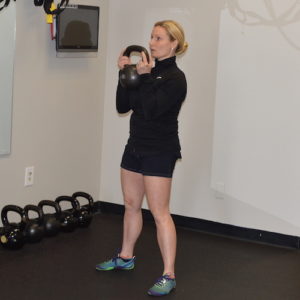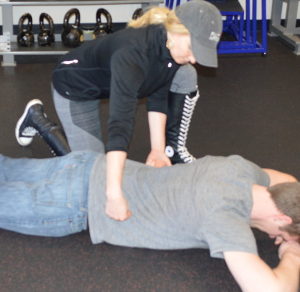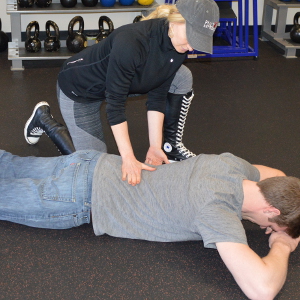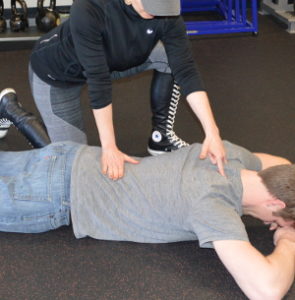Part 3 of 3 Part Series:
Part 3 – Core Stability and Breathing Techniques (You Are Here)
CORE STABILITY & BREATHING TECHNIQUES
Over the past weeks, I introduced the steps for a Killer Goblet Squat and the steps to perfect that squat by teaching the Face the Wall Squat. In this final installment of the Build a Killer Squat series, I focus on Core Stability and Proper Breathing Technique while performing the squat.
A proper squat is all about maintaining proper spinal stability. When you combine the coordinated bracing ability of your core muscles and harness the power of your breath you allow your body to move properly and squat the amount of weight you want.
Core Stability
The quality of your movement during the squat is dictated by how stable your core is. A bare spine, without any muscles, is nothing but a stack of bones. Without the continuous collaboration of the muscles that make up our core along with the fascia that holds them together, the weight of your upper body alone would be enough to collapse your spine.
Core stability is the synchronous action of the abdominal muscles along with the muscles of the back, hip, pelvic girdle, diaphragm and surrounding fascia. By working together they keep the spine in a safe and stable position while you move. The essence of stability is based on two things: timing and coordinated recruitment.
 In order to recruit your core muscles prior to the squat the cue “get into your high tension stance” is recommended. This action increases the stability of your lower back and locks it into a good neutral position. When you turn-on these muscles prior to the descent of the squat you proactively prepare your body to handle the load that you are trying to squat.
In order to recruit your core muscles prior to the squat the cue “get into your high tension stance” is recommended. This action increases the stability of your lower back and locks it into a good neutral position. When you turn-on these muscles prior to the descent of the squat you proactively prepare your body to handle the load that you are trying to squat.
How to Perform High Tension Stance
“High Tension” is summarized by high intensity where power optimization is the key rather than power conservation. Each rep should look just as powerful no matter if it is 12kg or 48kg. This style focuses on a balance between high tension and relaxation.
- Tense your muscles. Muscles produce force by tensing, maximize the tension;
- Tense the joints. A loose joint absorbs the force meant to go elsewhere; it “leaks” power and is easily injured;
- Focus on breath and a strong core. Pressure from the core increases strength;
- Move from the ground. To maximize stability and to take advantage of the reactive forces.
Hardstyle Kettlebell training is where I learned the the practice of the total compression skill. RKC teaches how to focus the scattered energies of the body into a directed all-out effort while minimizing the odds of injuries.
Proper Breathing
It is not enough to get use high tension when you squat. If you want to squat with weights in a safe manner you must also learn how to breathe properly.
To learn how to properly breathe during the squat, try this simple test. Place one hand on your stomach and another on your side (near your lower ribs). Now take a big breath. If you did this properly you will feel your stomach rise and fall. You will also feel your lower rib cage expand laterally (out to the side). Essentially you are feeling the volume increasing inside your core. When we take a big breath the diaphragm just below our lungs contracts and will descend towards our stomach.
 To help you learn the proper breathing technique, I focus on Crocodile breathing.
To help you learn the proper breathing technique, I focus on Crocodile breathing.
Crocodile Breathing – Retrain your breathing
Crocodile breath is a yoga exercise or technique for teaching and training diaphragmatic breathing.
How to perform Crocodile Breathing
- Lie on the floor (prone or face down) with your forehead on the back of your hands – neck is in alignment with the rest of your spine – this is a relaxed position;

- Breathe in through the nose and feel the air move down past the chest into the “stomach.” When this happens, you will feel the abdomen push out against the ground and your obliques will push out to the sides. Your Lower back may rise and fall with your inhale and exhale. This should happen naturally without you forcing your stomach out;
- Once you have a comfortable inhale you simply exhale and begin again;
- Exhale fully before beginning the next breath cycle;
- You should avoid breathing into the chest first and raising the shoulders;
- Inhale and exhale through the nose at a natural pace taking 80% or larger inhalations and long exhalations;
- Do not be in a rush. Let your breathing come at a natural pace and be sure to feel the stomach push out into the floor.
 Benefits of Crocodile Breathing
Benefits of Crocodile Breathing
- A way to retrain your breathing and have a great feel for what it means to breath with your diaphragm;
- Mobilization your thoracic spine and when your thoracic spine can move well – your shoulder will move and function better. The diaphragm and intercostal muscles are integral to the proper functioning of your body – shoulder included.
Power Breathing
Once you have mastered crocodile breathing, Power breathing is the next step. Power breathing is taking a deep diaphragmatic breath to help maintain core engagement and upright form in the squat.
How to Perform Power Breathing:
- First take in about 75% of a maximal inhalation and then expel the air at really high pressure by pressing your tongue against your teeth making a “Tsssss” sound;
- Breathe into the stomach using the diaphragm don’t just raise the chest. Exhale through your mouth while plugging your teeth with your tongue. Hiss while
tensing the abs until a full contraction is obtained; - It does not have to be loud or be a certain sound. Any sound that comes out of your body when you are trying hard and forcefully exhaling is acceptable. This is a technique to increase tension;
- Timing is key. The exhalation should take place during the hardest aspect of a movement;
- The key to maximizing this reflex, however, is your ability to match the increase in internal pressure with exertion; “match the breath with the force.” This is a skill, and it will take practice;
- Doing this during the execution of the squat will often cause a forced grunt on the ascent. This happens when you try to limit the desire to exhale on the way up. This forced hold is called the valsalva maneuver. Limiting our breath from escaping in this powerful manner is essential in order to maintain our spinal stability;
- To perform the valsalva maneuver correctly, the breath is exhaled forcefully against a closed airway. This is where the saying “inhale on the way down and exhale on the way up” takes a turn;
- Finally, Contract your glutes and to tuck your tail under. This technique builds great abdominal definition and greatly increases overall strength.
Power Breathing must be done in a step-by-step manner. If you get into high tension first and then try to take a big breath, you limit how much pressure you can create
I hope that you have enjoyed this three part instructional series How to Build a Killer Squat. I hope we have helped you build your killer squat!
We are proud to say that we’ve helped hundreds of people in Howard County and the surrounding areas learn and perfect their squat. If your looking for a personal trainer near Marriottsville, Turf Valley, Waverly Woods, Woodmark, West Friendship, Eldersburg, Sykesville, Woodstock, Cooksville, Ellicott City, Mt. Hebron, Clarksville, Fulton, Laurel, Burtonsville, Highland, Silver Spring, Columbia, Ellicott City, Glen Elg, and Maple Lawn, we’d love to help you! Call us at 301-452-5547 to see for yourself. Mention this article for a free session!